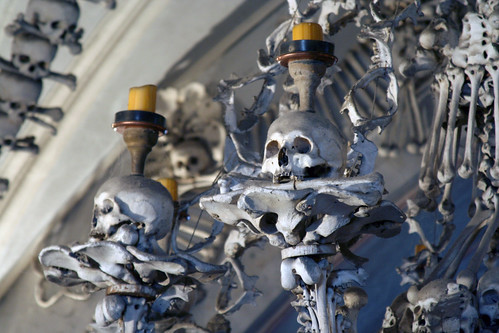Surprisingly, the effect is not nearly as ghoulish as I thought it would be. There's a beauty to how the bones from the 5000 or so skeletons are arranged. More mosaic than gorefest. I make this statement noting two exceptions: the dessicated, but still raggedly clothed corpse hanging on the wall (see below) and the foreboding inscription carved over the archway into the chapel. It roughly translates to "Our bones that are here await yours."

The practice exhuming skeletons and lining chapels with them hardly unique to Evora or Portugal. Ossuaries exist in a number of places throughout southern and eastern Europe. Notable among these is Sedlec in the Czech Republic. Sedlec's ossuary was built when a gothic church was built on the site of a mass grave (perhaps put there in the wake of the Black Plague). The estimated 50,000 skeletons here not only lined the walls, but were incorporated into every element of the church, including the chandelier pictured below.

What is not clear to me is which takes precedence - the need to store skeletons somewhere or the ostensible message of the bone chapels - that people need to realize that life on earth is fleeting and always exists side-by-side with death.
2 comments:
In the book that I am reading the hour of our death, one of the main studies is how death has been perceived over the last thousand years. What I thought interesting was, the author talks about how during these days of the plague and of these cemeteries with bodies dangling it intensified the fear, which is no surprise but he goes on to say that the lack of this constant reminder in our days intensifies the fear, into a denial of death. So perhaps a western interpreted desensitizing to death and murder is not based in over saturation but by the fact that we fear our own deaths so much that we don't want to hear about any kind of death.
Also in response to the etching on the chapel, the book that I have been writing for too many years which has helped to inspire this blog is called Hats Off (to those who have died and to those who will) It has a similar feel to the quote on the chapel.
There is a lot to be said about the denial of death that permeates our culture. I wouldn't say that the saturation of death has no impact however. I think that the media and entertainment industry's sensationalization of death actual stylizes death and thus transforms our expectations. So there is a schism between what we expect death to be and the gruesome reality that it really can be.
Post a Comment